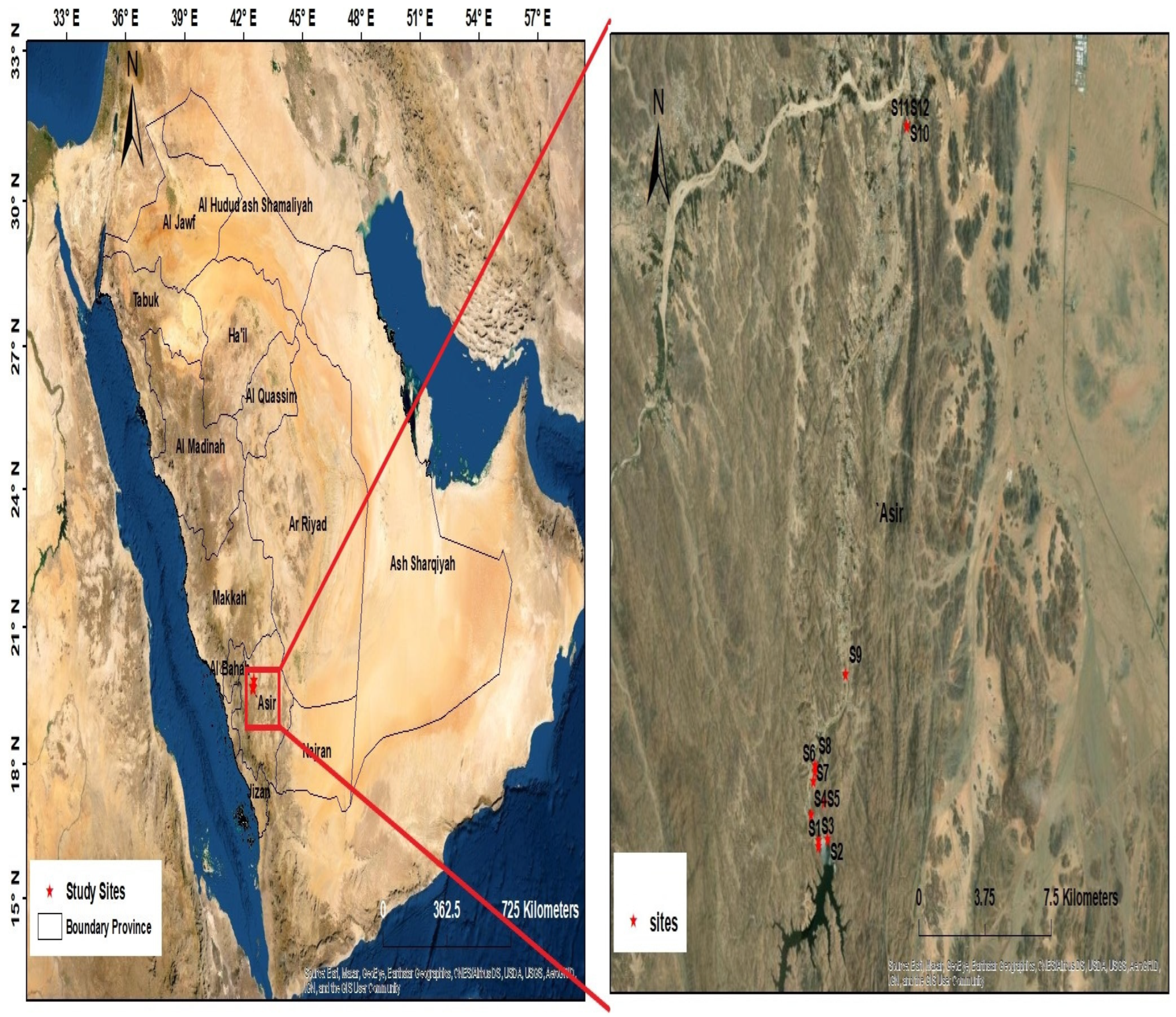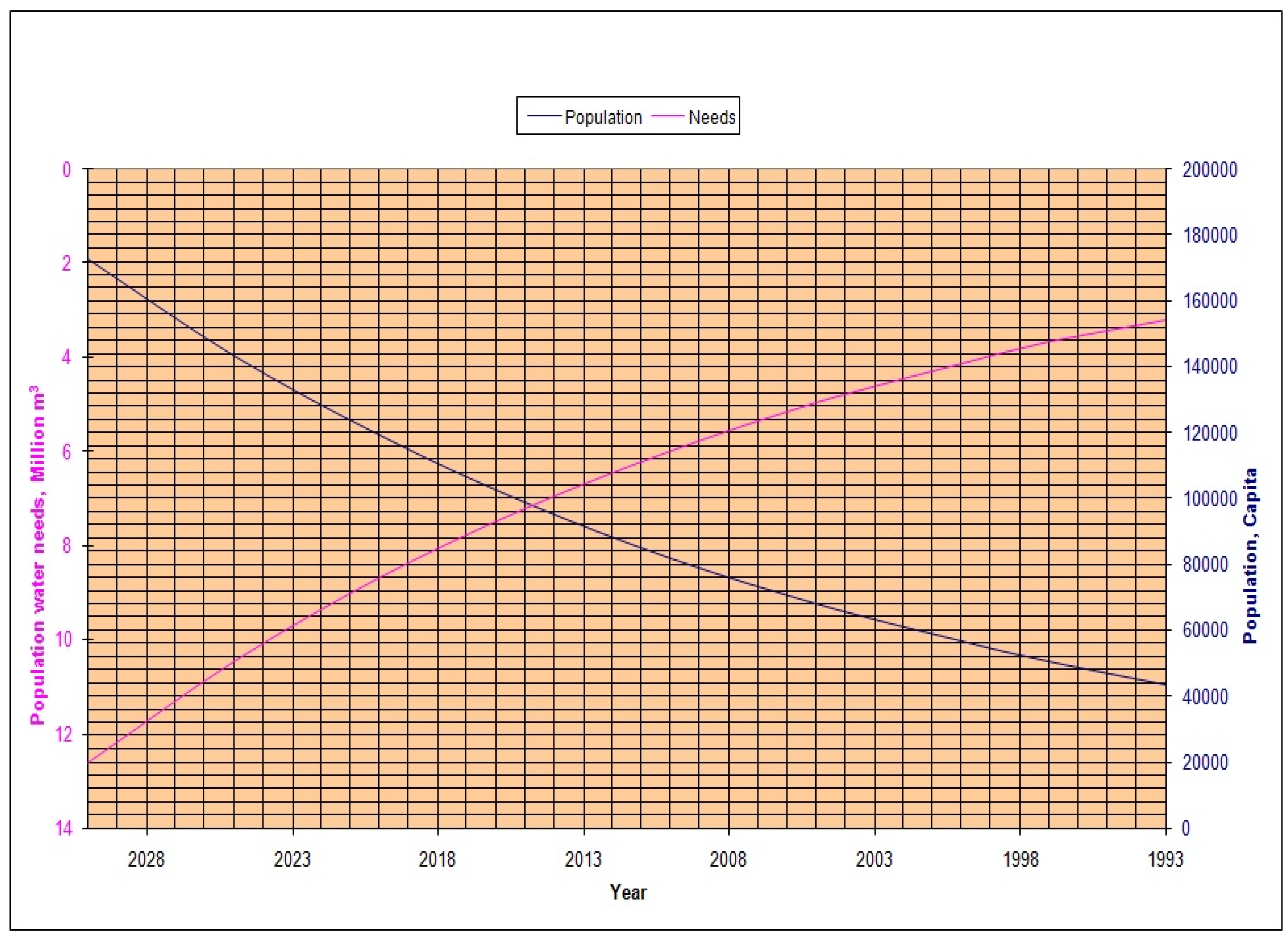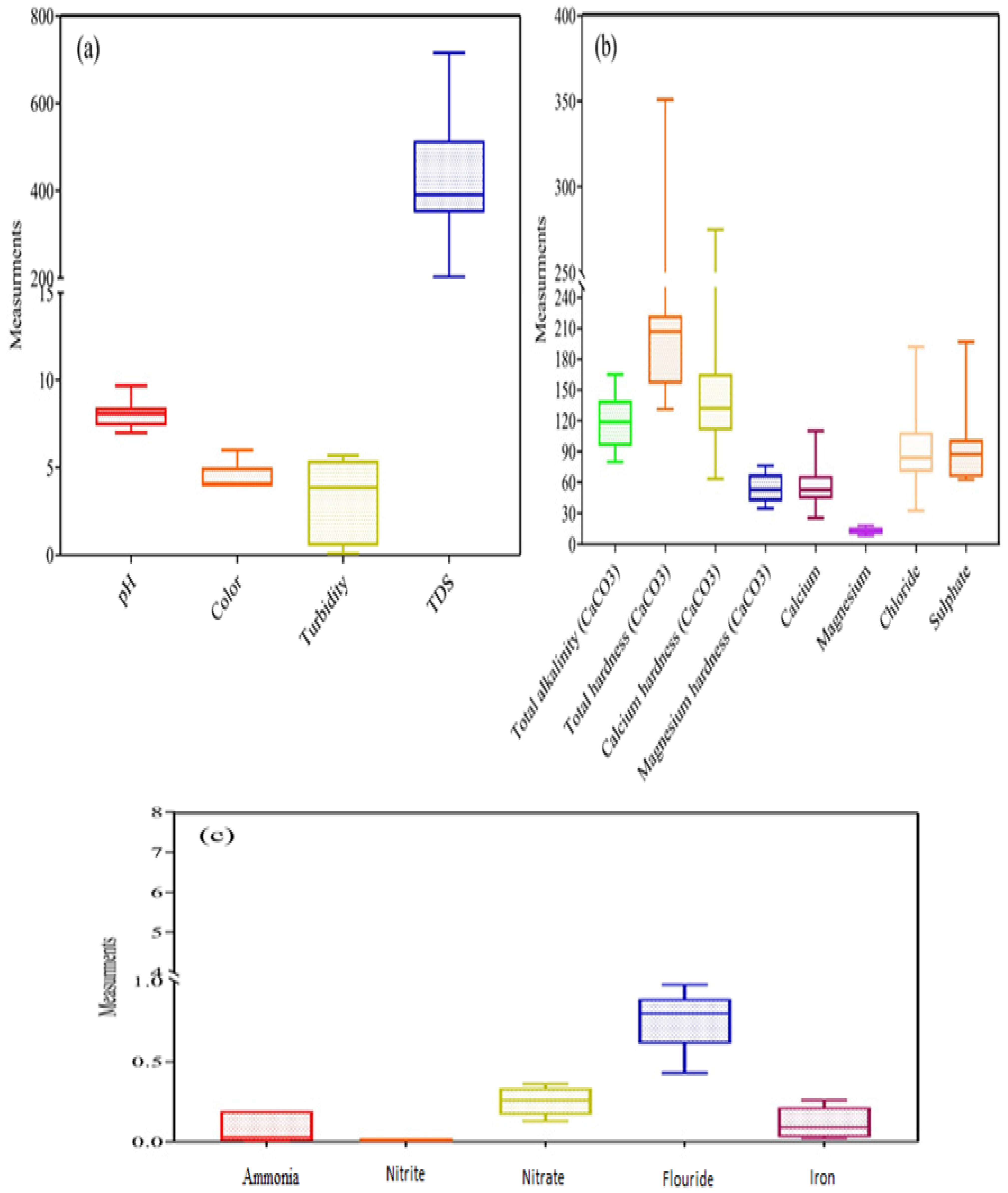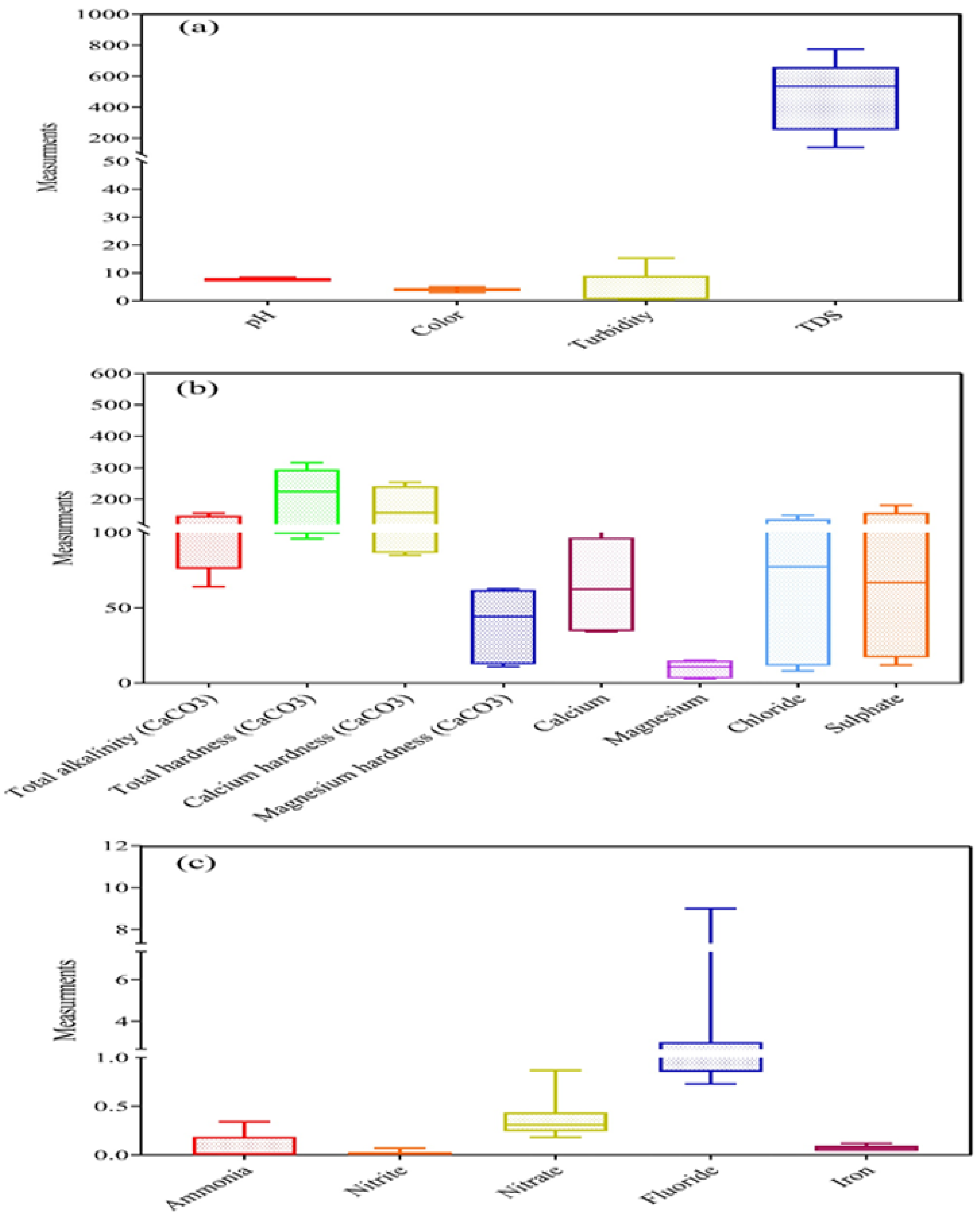View of Saudi Arabia Strategy for Water Resources Management at Bishah, Aseer Southern Region Water Assessment
Abstract
:1. Introduction
2. Materials and Methods
2.1. Sampling Sites
2.2. Water Analysis
2.3. Statistical Data Analysis
3. Results and Discussion
4. Conclusions
- groundwater levels be monitored (quantitative and qualitative) on a regular basis
- appropriate pollution control measures be implemented to ensure long-term groundwater quality.
- A need to monitor other pollution indicators, such as organic matter and agricultural wastewater content that leak into groundwater.
Author Contributions
Funding
Informed Consent Statement
Data Availability Statement
Acknowledgments
Conflicts of Interest
References
- European Environment Agency. Climate Change and Water Adaptation Issues; EEA Technical Report No 2/2007; European Environment Agency: Copenhagen, Denmark, 2007.
- UN-Water. World Water Development Report No. 3: Water in a Changing World; World Water Assessment Program, UNESCO: Paris, France, 2009. [Google Scholar]
- General Authority of Statistics. Statistical Indicators for Sustainable Development Goals; General Authority of Statistics: Riyadh, Saudi Arabia, 2019.
- US-Saudi Business Council. Water In Saudi Arabia: Desalination, Wastewater And Privatization; United Nations World Water Assessment Program, UNESCO: Paris, France, 2021. [Google Scholar]
- Wang, M.; Xu, Y.; Pan, S.; Zhang, J.; Zhong, A.; Song, H.; Ling, W. Long-Term Heavy Metal Pollution and Mortality in a Chinese Population: An Ecologic Study. Biol. Trace Element Res. 2010, 142, 362–379. [Google Scholar] [CrossRef] [PubMed]
- WHO, World Health Organization (WHO). Drinking-Water. World Health Organization Fact Sheets. 2018. Available online: http://who.int/entity/water_sanitation_health/publications/national-regulations-and-standards-for-drinking-water-quality/en/ (accessed on 9 May 2018).
- Li, P.; Wu, J. Drinking Water Quality and Public Health. Expo. Health 2019, 11, 73–79. [Google Scholar] [CrossRef]
- United Nations. Energy Statistics Yearbook; United Nations Department for Economic and Social Information and Policy Analysis, Statistics Division: New York, NY, USA, 2007. [Google Scholar]
- Solossa, H.F.; Yulfiah, Y. Mapping groundwater hardness in wells as a source of drinking water for the people. J. Appl. Sci. Manag. Eng. Technol. 2020, 1, 33–39. [Google Scholar] [CrossRef]
- Carrard, N.; Foster, T.; Willetts, J. Groundwater as a Source of Drinking Water in Southeast Asia and the Pacific: A Multi-Country Review of Current Reliance and Resource Concerns. Water 2019, 11, 1605. [Google Scholar] [CrossRef] [Green Version]
- Levallois, P.; Villanueva, C.M. Drinking Water Quality and Human Health: An Editorial. Int. J. Environ. Res. Public Health 2019, 16, 631. [Google Scholar] [CrossRef] [Green Version]
- WHO. World Malaria Report; World Health Organization (WHO): Geneva, Switzerland, 2018.
- Howard, G.; Calow, R.; Macdonald, A.; Bartram, J. Climate change and water and sanitation: Likely impacts and emerging trends for action. Annu. Rev. Environ. Resour. 2016, 41, 253–276. [Google Scholar] [CrossRef] [Green Version]
- Velis, M.; Conti, K.I.; Biermann, F. Groundwater and human development: Synergies and trade-offs within the context of the sustainable development goals. Sustain. Sci. 2017, 12, 1007–1017. [Google Scholar] [CrossRef] [Green Version]
- Guppy, L.; Uyttendaele, P.; Villholth, K.G.; Smakhtin, V.U. Groundwater and Sustainable Development Goals: Analysis of Inter Linkages; UNU-INWEH Report Series, Issue 04; United Nations University Institute for Water Environment and Health: Hamilton, ON, Canada, 2018. [Google Scholar]
- Margat, J.; Van der Gun, J. Groundwater around the World: A Geographic Synopsis; CRC Press Taylor & Francis Group: Boca Raton, FL, USA, 2013; 376p. [Google Scholar]
- Rusca, M.; Boakye-Ansah, A.S.; Loftus, A.; Ferrero, G.; van der Zaag, P. An interdisciplinary political ecology of drinking water quality. Exploring socio-ecological inequalities in Lilongwe’s water supply network. Geoforum 2017, 84, 138–146. [Google Scholar] [CrossRef]
- Jabed, A.; Paul, A.; Nath, T.K. Peoples’ Perception of the Water Salinity Impacts on Human Health: A Case Study in South-Eastern Coastal Region of Bangladesh. Expo. Health 2018, 12, 41–50. [Google Scholar] [CrossRef]
- Dey, N.C.; Parvez, M.; Saha, R.; Islam, M.R.; Akter, T.; Rahman, M.; Barua, M.; Islam, A. Water quality and willingness to pay for safe drinking water in Tala Upazila in a coastal district of Bangladesh. Expo. Health 2019, 11, 297–310. [Google Scholar] [CrossRef]
- Li, P.; Qian, H. Water resources research to support a sustainable China. Int. J. Water Resource. Dev. 2018, 34, 327–336. [Google Scholar] [CrossRef] [Green Version]
- Li, P.; Feng, W.; Xue, C.; Tian, R.; Wang, S. Spatiotemporal variability of contaminants in lake water and their risks to human health: A case study of the Shahu Lake tourist area, northwest China. Expo. Health 2017, 9, 213–225. [Google Scholar] [CrossRef]
- CDSI, Central Department of Statistics & Information: Saudi Arabia. 2010. Available online: http://www.cdsi.gov.sa/english/index.php?option=com_docman&Itemid=151 (accessed on 24 March 2022).
- APHA. Standard Methods for the Examination of Water and Wastewater, 23rd ed.; APHA, AWWA, WEF, Publication Office: Washington, DC, USA, 2017. [Google Scholar]
- SAS. Statistical Analysis System (SAS) User’s Guide: Statistics; SAS Institute Inc.: Cary, NC, USA, 2004. [Google Scholar]
- GAS. Population Characteristics Surveys; General Authority for Statistics: Riyadh, Saudi Arabia, 2017. [Google Scholar]
- MEWA (Ministry of Environment, Water and Agriculture). Annual Report; MEWA: Riyadh, Saudi Arabia, 2017.
- MEWA (Ministry of Environment, Water and Agriculture). The Study on Master Plan on Renewable Water Resources Development in the Southwest Region in the Kingdom of Saudi Arabia; MEWA: Riyadh, Saudi Arabia, 2013.
- WHO. Guidelines for drinking-water quality. World Health Organ. 2011, 216, 303–304. [Google Scholar]
- GSO, GCC Standardization Organization (GSO). Unbottled Drinking Water, Standard No. 149/2000; GSO: Riyadh, Saudi Arabia, 2014. [Google Scholar]
- Ibrahim, M.N. Assessing Groundwater Quality for Drinking Purpose in Jordan: Application of Water Quality Index. J. Ecol. Eng. 2019, 20, 101–111. [Google Scholar] [CrossRef]
- Bennett, L.; Drikas, M. The evaluation of color in natural waters. Water Res. 1993, 27, 1209–1218. [Google Scholar] [CrossRef]
- World Health Organization. Guidelines for Drinking-Water Quality: First Addendum to the Fourth Edition; World Health Organization: Geneva, Switzerland, 2017.
- Aish, A.M. Drinking water quality assessment of the Middle Governorate in the Gaza Strip, Palestine. Water Resource. Ind. 2013, 4, 13–20. [Google Scholar] [CrossRef] [Green Version]
- Abbas, M.; Barbieri, M.; Battistel, M.; Brattini, G.; Garone, A.; Parisse, B. Water Quality in the Gaza Strip: The Present Scenario. J. Water Resour. Prot. 2013, 5, 54–63. [Google Scholar] [CrossRef] [Green Version]
- Adimalla, N.; Li, P.; Qian, H. Evaluation of groundwater contamination for fluoride and nitrate in semi-arid region of NirmalProvince, South India: A special emphasis on human health risk assessment (HHRA). Hum. Ecol. Risk Assess 2017, 25, 1107–1124. [Google Scholar] [CrossRef]
- WHO. Guidelines for Drinking-Water Quality; World Health Organization: Geneva, Switzerland, 2011.
- Sawyer, C.N.; McCarty, P.L. Chemistry for Sanitary Engineer; McGraw-Hill: New York, NY, USA, 1967. [Google Scholar]
- Todd, D.K.; Mays, L.W. Groundwater Hydrology; John Wiley & Sons: Hoboken, NJ, USA, 2004. [Google Scholar]
- WHO. Nitrite in Drinking-Water; Background document for preparation of WHO Guidelines for drinking water quality; World Health Organization: Geneva, Switzerland, 2011.
- Loizidou, M.; Kapetanios, E. Effect of leachate from landfills on underground water quality. Sci. Total Environ. 1993, 128, 69–81. [Google Scholar] [CrossRef]
- Shomar, B. Groundwater of the Gaza Strip: Is it drinkable? Environ. Geol. 2006, 50, 743–751. [Google Scholar] [CrossRef]
- Quan, J. Status of fertilizer application in Weinan City and counter measures to achieve zero growth. Agric. Sci. Technol. News Lett. 2018, 3, 39–40. [Google Scholar]
- Duan, Q.; Jiao, J.; Chen, X.; Wang, X. Association between water fluoride and the level of children’s intelligence: A dose–response meta-analysis. Public Health 2018, 154, 87–97. [Google Scholar] [CrossRef] [PubMed]
- Ganyaglo, S.Y.; Gibrilla, A.; Teye, E.M.; Owusu, E.D.G.J.; Tettey, S.; Diabene, P.Y.; Asimah, S. Ground water fluoride contamination and probabilistic health risk assessment in fluoride endemic areas of the Upper East Region, Ghana. Chemosphere 2019, 233, 862–872. [Google Scholar] [CrossRef] [PubMed]
- Li, G.; Qian, H.; Zhang, X.; Guo, S.; Zhang, M. Investigation and analysis of drinking fluorosis in Weinan City. Chin. J. Endem. 2009, 128, 68–69. [Google Scholar]
- Liu, R. Study on Transference and Transform Simulation of Fluoride in Groundwater and Relation between Fluoride and Human Body Health in Dali Region, Guanzhong Basin; Chang’an University: Xi’an, China, 2009. [Google Scholar]
- Chowdhury, S.; Mazumder, M.J.; Al-Attas, O.; Husain, T. Heavy metals in drinking water: Occurrences, implications, and future needs in developing countries. Sci. Total Environ. 2016, 569–570, 476–488. [Google Scholar] [CrossRef]
- Barakat, M. New trends in removing heavy metals from industrial wastewater. Arab. J. Chem. 2011, 4, 361–377. [Google Scholar] [CrossRef] [Green Version]




| Parameters | Unit | WHO [28] | GSO [29] |
|---|---|---|---|
| pH | 6.5–8.5 | 6.5–8.5 | |
| Color | 15 | 15 | |
| Turbidity | NTU | 5 | 5 |
| Total Dissolved Solids (TDS) | mg/L | 1000 | 1000 |
| Total alkalinity (CaCO3) | mg/L | ||
| Total hardness (CaCO3) | mg/L | 500 | 500 |
| Chloride | mg/L | 250 | 250 |
| Sulphate | mg/L | 250 | 250 |
| Ammonia | mg/L | 1.5 | 1.5 |
| Nitrite | mg/L | 3 | 3 |
| Nitrate | mg/L | 50 | 50 |
| Fluoride | mg/L | 1.5 | 1.5 |
| Iron | mg/L | 0.3 | 0.3 |
| Total coliform | MPN/100 mL | -ve | -ve |
| E. coli | MPN/100 mL | -ve | -ve |
| Parameter, SD | Unit | Wadi Bishah (1) | King Fahd Lake Dam | Bishah Dam | Bishah Wells (1–5) | Well Lake (1) | Well Lake (2) | Infiltration Pond | King Fahd Station, Bisha | Bishah Tank | SD |
|---|---|---|---|---|---|---|---|---|---|---|---|
| pH | 7.20 | 7.98 | 8.47 | 8.10 | 8.33 | 9.70 | 8.40 | 7.00 | 7.62 | 0.721 | |
| Color | Co/Pt unit | 5 | 4 | 5 | 4 | 4 | 5 | 6 | 4 | 4 | 2.42 |
| Turbidity | NTU | 5.70 | 3.86 | 5.51 | 0.10 | 5.32 | 2.80 | 5.00 | 0.60 | 0.45 | 1.275 |
| TDS | mg/L | 716 | 391 | 334 | 495 | 386 | 202 | 450 | 535 | 367 | 225.1 |
| Total alkalinity (CaCO3) | mg/L | 141 | 80 | 111 | 165 | 110 | 81 | 119 | 124 | 138 | 44.3 |
| Total hardness (CaCO3) | mg/L | 351 | 207 | 160 | 221 | 155 | 131 | 157 | 218 | 224 | 83.3 |
| Calcium hardness (CaCO3) | mg/L | 275 | 132 | 112 | 168 | 124 | 63 | 109 | 164 | 156 | 60.7 |
| Magnesium hardness (CaCO3) | mg/L | 76 | 75 | 48 | 53 | 35 | 35 | 48 | 54 | 61 | 22.7 |
| Calcium | mg/L | 110 | 53 | 45 | 67 | 50 | 25 | 44 | 66 | 62 | 21.67 |
| Magnesium | mg/L | 18.3 | 17.9 | 11.5 | 12.7 | 8.4 | 8.4 | 11.5 | 13 | 15 | 5.43 |
| Chloride | mg/L | 192 | 104 | 63 | 84 | 114 | 33 | 84 | 102 | 77 | 47.2 |
| Sulphate | mg/L | 197 | 107 | 87 | 87 | 97 | 63 | 64 | 90 | 67 | 43.7 |
| Ammonia | mg/L | 0.01 | 0.01 | 0.01 | 0.34 | 0.20 | 0.02 | 0.17 | 0.01 | 0.01 | 0.082 |
| Nitrite | mg/L | 0.01 | 0.01 | 0.01 | 0.07 | 0.01 | 0.01 | 0.04 | 0.02 | 0.01 | 0.047 |
| Nitrate | mg/L | 0.44 | 0.24 | 0.30 | 0.18 | 0.25 | 0.87 | 0.43 | 0.33 | 0.31 | 2.65 |
| Fluoride | mg/L | 0.73 | 1.10 | 1.97 | 3.00 | 1.40 | 0.73 | 9.00 | 3.00 | 0.98 | 0.105 |
| Iron | mg/L | 0.08 | 0.04 | 0.09 | 0.04 | 0.04 | 0.10 | 0.12 | 0.07 | 0.04 | 0.044 |
| Total coliform | MPN/100 mL | -ve | -ve | -ve | -ve | -ve | -ve | +ve | -ve | -ve | |
| E. coli | MPN/100 mL | -ve | -ve | -ve | -ve | -ve | -ve | +ve | -ve | -ve |
| Parameter | Unit | Wadi Bishah (2) | Bishah Tank | Ashyab King Fahd Dam | Wadi Hergab | Tabala Dam (Pure Water) | SD |
|---|---|---|---|---|---|---|---|
| pH | 8.23 | 7.62 | 8.11 | 7.90 | 8.20 | 0.656 | |
| Color | Co/Pt unit | 4 | 4 | 7 | 7 | 4 | 2.42 |
| Turbidity | NTU | 4.54 | 0.45 | 0.84 | 5.30 | 7.82 | 1.275 |
| TDS | mg/L | 564 | 367 | 469 | 140 | 129 | 125.1 |
| Total alkalinity (CaCO3) | mg/L | 112 | 138 | 155 | 64 | 88 | 44.3 |
| Total hardness (CaCO3) | mg/L | 316 | 224 | 272 | 102 | 96 | 76.3 |
| Calcium hardness (CaCO3) | mg/L | 254 | 156 | 228 | 88 | 85 | 59.7 |
| Magnesium hardness (CaCO3) | mg/L | 63 | 61 | 44 | 14 | 11 | 22.7 |
| Calcium | mg/L | 102 | 62 | 91 | 35 | 34 | 23.67 |
| Magnesium | mg/L | 15.1 | 14.7 | 10.6 | 3.4 | 2.6 | 5.33 |
| Chloride | mg/L | 148 | 77 | 124 | 15 | 8 | 47.2 |
| Sulphate | mg/L | 180 | 67 | 132 | 22 | 12 | 47.7 |
| Ammonia | mg/L | 0.03 | 0.01 | 0.01 | 0.19 | 0.19 | 0.091 |
| Nitrite | mg/L | 0.01 | 0.01 | 0.01 | 0.01 | 0.01 | 0.052 |
| Nitrate | mg/L | 0.36 | 0.31 | 0.26 | 0.13 | 0.21 | 2.73 |
| Fluoride | mg/L | 0.43 | 0.98 | 0.80 | 0.80 | 0.80 | 0.108 |
| Iron | mg/L | 0.09 | 0.04 | 0.02 | 0.17 | 0.26 | 0.053 |
| Total coliform | MPN/100 mL | -ve | -ve | -ve | -ve | +ve | |
| E. coli | MPN/100 mL | -ve | -ve | -ve | -ve | +ve |
| Trace Elements | Min. | Max. | Mean | SD | WHO [28] | GSO [29] |
|---|---|---|---|---|---|---|
| Al | 0.035 | 0.200 | 0.119 | 0.058 | 0.200 | 0.200 |
| Cr | 0.001 | 0.050 | 0.002 | 0.015 | 0.050 | 0.050 |
| As | 0.001 | 0.010 | 0.002 | 0.003 | 0.010 | 0.010 |
| Se | 0.001 | 0.100 | 0.004 | 0.030 | 0.010 | 0.010 |
| Zn | 0.001 | 3.000 | 0.007 | 0.947 | 3.000 | 3.000 |
| Cd | 0.001 | 0.003 | 0.000 | 0.001 | 0.003 | 0.003 |
| Ba | 0.032 | 0.700 | 0.043 | 0.208 | 1.300 | 0.700 |
| Pb | 0.001 | 0.010 | 0.003 | 0.003 | 0.010 | 0.010 |
| B | 0.286 | 0.500 | 0.395 | 0.069 | 2.400 | 0.500 |
| Mo | 0.002 | 0.070 | 0.004 | 0.021 | 0.070 | 0.070 |
| Cu | 0.001 | 1.000 | 0.003 | 0.315 | 2.000 | 2.000 |
| Ni | 0.009 | 0.167 | 0.033 | 0.048 | 0.070 | 0.070 |
Publisher’s Note: MDPI stays neutral with regard to jurisdictional claims in published maps and institutional affiliations. |
© 2022 by the authors. Licensee MDPI, Basel, Switzerland. This article is an open access article distributed under the terms and conditions of the Creative Commons Attribution (CC BY) license (https://creativecommons.org/licenses/by/4.0/).
Share and Cite
Fazel, H.K.; Abdo, S.M.; Althaqafi, A.; Eldosari, S.H.; Zhu, B.-K.; Safaa, H.M. View of Saudi Arabia Strategy for Water Resources Management at Bishah, Aseer Southern Region Water Assessment. Sustainability 2022, 14, 4198. https://doi.org/10.3390/su14074198
Fazel HK, Abdo SM, Althaqafi A, Eldosari SH, Zhu B-K, Safaa HM. View of Saudi Arabia Strategy for Water Resources Management at Bishah, Aseer Southern Region Water Assessment. Sustainability. 2022; 14(7):4198. https://doi.org/10.3390/su14074198
Chicago/Turabian StyleFazel, Hesham K., Sayeda M. Abdo, Atiah Althaqafi, Saad H. Eldosari, Bao-Ku Zhu, and Hosam M. Safaa. 2022. "View of Saudi Arabia Strategy for Water Resources Management at Bishah, Aseer Southern Region Water Assessment" Sustainability 14, no. 7: 4198. https://doi.org/10.3390/su14074198
APA StyleFazel, H. K., Abdo, S. M., Althaqafi, A., Eldosari, S. H., Zhu, B.-K., & Safaa, H. M. (2022). View of Saudi Arabia Strategy for Water Resources Management at Bishah, Aseer Southern Region Water Assessment. Sustainability, 14(7), 4198. https://doi.org/10.3390/su14074198








